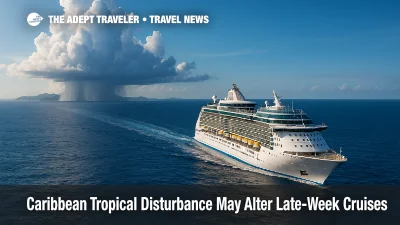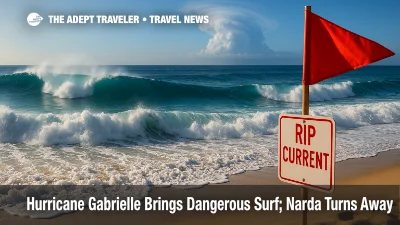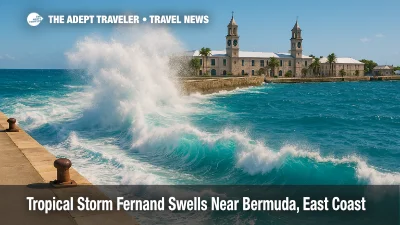Anguilla
Imagine stepping onto the soft, powdery sands of Anguilla, where the sky seems to merge with the endless, azure sea, and you’ll find yourself lost in a world that’s both serene and vibrant. Travel to Anguilla and all these vivid snapshots become a mosaic of experiences: each gentle wave that laps at the shoreline carries whispers of stories, inviting reflections on time and nature. Honestly, when you think of Anguilla—and honestly, it’s surprising how hidden yet inviting it feels—it’s like catching a whiff of salt in the breeze mixed with the floral notes from nearby blossoms. There's something alluring about savoring the tang of fresh seafood, prepared with the warmth and love that's palpable in each bite, while the rhythmic, offbeat tunes of calypso tangle with laughter carried by the wind. Maybe there's a certain magic in the contrast, the quiet harmony of the island—something that gets you thinking, what exactly makes this place so enchanting? Travel to Anguilla, and it's a blend of sensory impressions, a constantly shifting tapestry of serenity and celebration that keeps calling you back, weaving new narratives before your eyes. And come to think of it, isn’t it oddly compelling how Anguilla remains both an escape and home for travelers seeking deeper connection, deeper rest, or perhaps something unnameable that a place holds? However, as I write this, I'm struck by the idea that maybe it's not about finding out, but simply experiencing it as it comes, much like allowing these words to spill out as they may, in a form that's true to the feeling of this island.
Anguilla Travel Season
Travel to Anguilla is a classic dream: sun-drenched beaches, gentle breezes, and azure waters. When is the best time to make this dream a reality? The peak season for travel to Anguilla stretches from mid-December to mid-April, coinciding with winter in the northern hemisphere. It's when you're likely to find the island at its most vibrant—and, let's be honest, most crowded. Everybody wants to escape the cold, and that's okay. The weather tends to be stunningly perfect, with gentle temperatures and minimal rainfall—think paradise. You could even argue that it's worth the crowd just for a slice of this tranquility, but then again, perhaps not everyone loves crowds. Hm, to each their own I suppose.
So, what if you want Anguilla to yourself, or at least more to yourself? Well, visiting Anguilla during the shoulder seasons—right at the edges of peak months—might just be the ticket. We're talking late April or early November. It's like having your cake and eating it too. You'll still have that beautiful weather Anguilla is known for, but with fewer people vying for the same space. Have you ever wandered a nearly empty beach and felt like the whole world was just yours? That's the vibe. Days stretch lazily, nights are calm, and your favorite spots remain blissfully uncrowded. It’s odd too that something as simple as timing can shape an entire experience.
But, if you’re intrigued by the off-peak perks—savings in both money and serenity—consider travel to Anguilla during the low season, late summer into early fall. The humidity cranks up, sure, and the occasional storm might keep you on your toes, but this is also a time when the island embraces a quieter pace. Ah, the tranquility. Hotel rates can drop significantly, and it's like the island itself draws a softer breath. You might even find you have the chef’s undivided attention at that hidden gem of a restaurant. There’s a romance in that solitude, something a bit poetic. Then again, some folks just aren't fond of potential storms.
On another note, local events can add an engaging layer to your visit. Anguilla's Carnival, held in August, is a riot of colors, music, and joy, a vibrant display of the island's cultural heartbeat. It’s like stepping into another world—and sometimes, literally into a street parade! Off-peak doesn't mean off-event, and that's part of the charm. Travel to Anguilla during these times might just align you with an unexpected festival or holiday adding a bit of spice to an otherwise serene getaway.
The writing itself is curious—it’s like I’m sorting through it, trying to map out the layers but also slipping into these tangents. I mean, the very idea of travel to Anguilla feels dream-like and scattered enough, doesn’t it? Funny how it mirrors the way I’ve come to see it, scattered yet vibrant, much like the island itself. There's an art to embracing a place fully, whether it’s packed with tourists or almost eerily empty. Ah, the musings of a travel whimsy… Well, worth it, somehow.
The Weather and Seasons in Anguilla
The weather in Anguilla is like a best friend—sometimes moody with little surprises, but mostly just warm and inviting. When you think about traveling, especially when you travel to Anguilla, you want to imagine basking in relentless sunshine on white sandy beaches. Well, that's pretty much what you get. The island boasts a tropical climate all year round, with temperatures generally hovering around 80°F to 88°F (27°C to 31°C). It's remarkable how the temperature doesn’t swing much; it’s almost like everything’s done to lull you into a relaxed, sun-soaked daze.
Okay, let’s get into the nitty-gritty, though. The so-called 'cool' season runs from December through March, where you experience slightly lower temperatures, around 70°F to 75°F (21°C to 24°C) in the evenings, kinda like a soft whisper against your skin after the day's sunny embrace. This is also when the island is flooded, practically swooning, with tourists because the weather conditions are most favorable. It's almost like there’s this dance of people coming in droves, having escaped colder climates, and the island reciprocates their need for warmth.
But wait—April to November has its own story to tell, don’t underestimate it. The heat cranks up a little, and you have temperatures spiking to 90°F (32°C) at times. But it's also when the showers come, as if the sky decides it's time for Anguilla to have a little cool down with periodic, yet not terribly inconvenient, showers. Rainfall is most frequent between August and November. Still, it’s a quizzical thing, isn’t it? It rains, but not enough to dampen spirits or set off that inner alert button that screams, “Weather chaos!”
The humidity, on the other hand, can be a stubborn friend who just refuses to leave; it wiggles its way through the air more consistently during the wet season. But is it actually the bad guy here? I wonder, because there’s something so refreshing about a balmy evening, soft Caribbean breezes smoothing over whatever cares have tagged along on your journey. And travel to Anguilla during this time? Well, it's slightly less crowded, offers slightly better prices, and it still provides all that beachy delight, with perhaps just a cloud or two introducing itself now and then.
Weather and Travel Plans
When planning your travel to Anguilla, you’d want to take these weather quirks into account. Thoughtfully, Anguilla knows how to keep its rhythm easygoing, even when the rain taps on the rooftops. The significant seasonal change not only affects temperatures but kind of dictates the pace of life there too. It’s fascinating how this tiny dot in the Caribbean attracts a wave of visitors during its dry period, isn’t it? But really, any time can be a good time to roll the dice on travel plans—it's just a matter of what kind of vibe you're after. There’s just something about experiencing different faces of its weather that really fills out the story of your visit.
Accepted Payment Methods and Other Payment Information in Anguilla
Travel to Anguilla can be an enchanting journey, in more ways than one. When you land on this Caribbean gem, tucked away in the warm embrace of the ocean, your first taste of the local vibe often starts with how you pay. Anguilla, you see, uses the Eastern Caribbean dollar (XCD) as its official currency, but it’s interesting because the US dollar is commonly accepted too. It’s one of those places where you could—and perhaps should—carry both. Huh, kind of thinkin' about it now, it's probably because of the steady influx of American travelers. It’s like they couldn’t decide in the past, and now they’ve got this hybrid system that works pretty well for most folks involved.
Speaking of payments, when you travel around Anguilla, cash remains king in many intimate settings, you know, like those small local eateries or beachside stalls where you just pick up a fresh coconut. But, it’s also a space where your trusty plastic pal, the credit card, can step in—Visa and Mastercard are, unsurprisingly, the most widely accepted. It seems, come to think of it, like there’s this unsaid rule about card types. American Express, ah it’s a bit tricky, and Discover can be like finding a unicorn. You might wonder, with AMEX, if it just feels a bit misunderstood, not quite as embraced by establishments here. So, it might be a wise move not to rely on it too heavily if you're planning a trip.
A funny thing about credit cards in Anguilla, and this could catch you off guard, is sometimes places add a small surcharge for card payments. Yeah, it’s like an additional nugget of surprise, unwelcome, at that, anyway mostly it's because handling cash just keeps it simple for them. And if you're planning to visit automated teller machines, remember, they hand out the Eastern Caribbean dollar. It’s a little amusing, I guess—it’s like a nudge from the island saying, “welcome to our world, start using our coins.”
Tipping! Oh, here’s where it gets culturally interesting again. When you're traveling through Anguilla, tipping is, well, expected and appreciated, particularly in service sectors like dining. Restaurants often add a service charge to your bill, usually around 10%. This becomes a reassuring habit if you ask me, eliminating the second-guessing on what’s appropriate. But leaving a bit more for exceptional service—still a thoughtful gesture. The taxi drivers, the ones who ferry you to your sun-doused destinations, they too expect a little token of appreciation. A tip here and there, a show of gratitude, the coinage of kindness, as one might say. It’s a small but important part of the experience, and it's like participating in this unspoken dialogue of good will.
And all this really makes you ponder the dance of payment methods on this island, doesn’t it? How cash, cards, and context shape the experience for visitors and locals alike. Payment in Anguilla is a blend of all things Caribbean—it’s laid-back yet practical, with a hint of adaptation thrown in. Yet, ponder for a moment longer, if the charm of travel to Anguilla is partly defined by... this ebb and flow of transaction rituals. Do you ever think about that? I certainly hadn’t until I started typing this, but it's almost as if I can feel the rhythm of island life through its currency and customs. Strange, but delightful.
Why You Should Travel to Anguilla
Pristine Beaches with Unspoiled Beauty
When you travel to Anguilla, you quickly realize that the island's beaches aren’t just a backdrop—they're the main event. That powdery white sand, stretching for seemingly endless miles, and the clear, turquoise waters are a picture-perfect paradise. It’s almost like stepping into a dream, really, where time—unexpectedly—slows down. This is the place for those seeking tranquility, although I sometimes wonder, do we oversell tranquility as if everyone seeks only peace? Well, Anguilla certainly makes it seem worth chasing.
A Culinary Experience that Surprises
Ah, the cuisine. What's funny is that Anguilla, a small island, hosts such a big flavor. The local food—it's something else. Imagine savoring fresh seafood, infused with a mix of Caribbean and international influences. You might find a tiny shack serving unusual pairings, and then a five-star restaurant handling flavors with all the precision of an art form. Lobster on the beach? Yes. Suddenly, eating becomes an experience worth traveling for, and isn’t it curious how much a meal can shift our perspective of a place?
The Rich Traditions and Heritage
Travel to Anguilla, and you get a sense that the island holds a deep, almost tangible history. From boat racing, which is practically a national pastime, to their vibrant carnival celebrations, there's truly a cultural scene that demands your attention. It’s as if the island invites you to be more than a visitor, almost slipping into the role of a participant. I sometimes think culture is a gateway, opening paths we didn't imagine we'd tread. Places like the Heritage Collection Museum remind us of the stories and struggles that shape these experiences.
Opulent Resorts that Provide an Escape
Speaking of indulgence, Anguilla's resorts live up to every whispered promise of luxury. It's the kind of sophisticated escape you find in glossy magazines, yet somehow more tangible. Think personalized service, private pools, and ocean views that—come to think of it—even the vivid snapshots in your mind wouldn't do justice. Though, I wonder if we sometimes romanticize luxury, placing it on a pedestal, while the real essence of a place is found elsewhere?
Unmatched Seclusion for the Ultimate Retreat
If privacy is what you're seeking, travel to Anguilla might just be your most rewarding decision. Far from crowded tourist hubs, the island provides an unmatched sense of seclusion. Here, solitude is abundant, a rarity in this digitally connected age. Some might argue enjoyment shouldn’t equate to isolation, yet there’s undeniable pleasure in finding a quiet slice of the world. It's a paradox, isn't it? Craving both community and solitude in equal measure.
Wildlife and Natural Wonders
It's not just beaches and history—Anguilla has its own share of natural beauty that goes beyond the mundane. Don’t be surprised to spot fascinating wildlife or explore intriguing rock formations like the Devil's Bay. These natural elements add another layer of allure. It’s a captivating reminder that even in places renowned for relaxation, there’s adventure if you dare. I sometimes ponder how nature so effortlessly captivates us, grounding our experiences in reality.
A Vibrant Music Scene
And, oh, the music. Sounds in Anguilla are as much a part of the travel experience as the sights. With a vibrant reggae and soca scene, music pulses through the island, creating rhythms that seem to sync with the heartbeat of life there. It’s an audial tapestry that, oddly enough, seems to play just within earshot, reminding us to look closer, listen deeper. I’ve often mused on how music transforms space, making it as a form of connection—both with others and within ourselves.
Diverse Water Activities for All Levels
Water enthusiasts would find their dreams realized when they travel to Anguilla. Whether it’s snorkeling among lively reefs, diving into the depths, or sailing against warm breezes, there’s a different kind of thrill waiting at every corner. Isn’t it fascinating how bodies of water invite us to explore beneath the surface, metaphorically and literally? Though, it’s true, not everyone is drawn to water like a magnet—still, for those who are, it offers a unique pull.
Artisanal Shopping Experiences
Shopping in Anguilla means discovering something unexpected—crafts that seem to weave tradition into modern aesthetics. Local artists and craftsmen offer pieces full of character, impossible in mainstream mass production. It's curious how these objects, small in stature, often hold the largest stories, encouraging us to collect, ponder, and celebrate tradition. And isn’t that an intriguing quirk of travel? The tangible memories, allowing wanderlust to linger.
A Welcoming Community
Finally, there’s the people. Anguillans display an openness that is both refreshing and inviting. Conversations in local spots or simply during a stroll down the beach remind travelers that beyond relaxation and beauty, human connection marks the true highlight. Perhaps it's the collective island demeanor that draws every part of Anguilla together, yet, many times, I wonder, do we truly appreciate the role of community in defining a travel experience?
The History of Anguilla
Anguilla, a small Caribbean gem, has a rather intriguing history that’s both old and new, if that makes sense. Or maybe—come to think of it—it straddles the line between being ancient and not-so-ancient due to its indigenous roots and colonial chapters. You might think ‘Why travel to Anguilla when it’s so tiny?’ Well, even though it can slip under the radar, history lovers find endless fascination here. Picture this: the island's story begins with the Arawak people, who first paddled to these shores long, long ago. Their presence is still felt today, but we're getting to that. There's something about the gentle whisper of its past that seems to linger on the sea breeze.
And, let's talk about colonial influence because, let’s be honest, it’s a staple of Caribbean history. Anguilla became a British colony centuries later in the 17th century after European settlement went full throttle. It's odd when you think about how the island was sort of a pawn in the empires’ game, tossed around like a hot potato between powers before finally sticking with the British. And here's a fun fact—during the Anguilla Revolution of 1967, its residents decided they'd rather go their own way than be blended into a federation with Saint Kitts and Nevis. I mean, who could blame them? They even went so far as to declare independence, for like a brief shining moment. But don't be fooled, this act of defiance was not just a blip on the radar; it crystallized Anguilla's enduring spirit for autonomy. It's little things like this that make travel to Anguilla for its history kind of a must-do.
Right, about those traces of the Arawak—visiting Anguilla's cultural landmarks offers a connection to these peoples that I find surprisingly vivid. Like, there's something grounding about wandering through the Heritage Museum Collection, feeling the pull of stories housed in every artifact. Yet, it’s kind of like the Arawak's mark remains a whisper—that you can hear, if you just stop and listen. At sites like the Fountain Cavern National Park, petroglyphs carved by their hands hang etched on stone walls, telling us stories in a language that we don't quite understand but still oddly resonates. And let’s be real for a second, aren’t these the types of experiences that ignites the excitement of history lovers? Come to think of it, wandering these spaces holds more allure than any history book could.
Culture has this way of blending with history until the two are almost indistinguishable, wouldn't you say? The island’s cultural festivals embrace this idea. If you travel to Anguilla during the summer festival, you'll catch a glimpse of this fusion—where colonial and indigenous influences twist together in the rhythm of carnival. It’s fascinating how, despite the colonial remnants, Anguilla has shaped its authentic island identity, colored with vibrant traditions. It sometimes makes me ponder whether the island’s cultural synthesis is a celebration or a form of resistance, or maybe somehow both. A visit here for its rich history gives you this weird sense that you're tapping into the island's soul—or should I say its many souls? So, when planning your next historical escapade, don't sleep on Anguilla. It’s a place where the steady drumbeat of the past informs the present in the most unexpectedly profound ways.
The Culture of Anguilla
When you think about travel to Anguilla, it’s like picturing a melody that’s uniquely its own, a place that dances to its own rhythm. The island's culture is an intriguing mix of African heritage and European influences, layering a rich tapestry with vibrant, warm hues. Traditional music, like reggae and calypso, pulses through the air—it's almost mesmerizing how you can feel it in your bones. This isn't just music; it's a heartbeat, a language of the soul, like a conversation shared without words. And come to think of it, it’s often the spontaneous gatherings that showcase this best. You might find people gathered around with instruments, letting the music tell stories of both past and present. It makes you wonder how many stories truly lie hidden in those melodies.
Festivals, oh, they’re something else entirely here. Festivities in Anguilla are like a beautiful burst of life, full of colors and traditions that seem to echo through time. The annual Summer Festival stands out—it’s a time when the island's vibrant spirit is most alive. Carnival parades, boat races, and music festivals—there's a certain thrill, an infectious energy that sweeps through the streets. It’s these times, you realize, where culture is not just seen but felt, almost as if the island itself is speaking, inviting travelers to join its celebration. It might sound a bit romanticized, but seriously, there's some magic in how Anguilla embraces revelry while nodding to its roots. What’s peculiar, though, is how seamlessly this blends with the more subdued, daily life customs, like a tide coming in and out, unhurried yet inevitable.
Daily life here in Anguilla also reflects this fascinating contrast. The locals are incredibly warm and welcoming, often moving at a slower pace, which feels like a charming defiance against the hustle of the modern world. You’ll notice gatherings are an intimate but integral part of everyday life—whether it's around a pot of steaming stew or during a casual game of dominoes. Yet, it's the subtle things that stay with you, like the gentle lilt in their speech or the rhythmic tap of feet on sand as children play. Perhaps it’s odd, but everyday routines here seem imbued with a certain reverence, a mindful appreciation for both moments and the island itself, as though they are aware of their uniqueness and cherish it deeply.
And let's not forget, Anguilla’s commitment to preserving its cultural essence is quite noteworthy. There’s this respectful acknowledgment of history and a gentle resistance to being swept away by outside influences. Efforts to maintain indigenous traditions shine through various cultural preservation initiatives, ensuring that the island remains true to its roots even as it accommodates the influx of travelers. So, why should you make the trip to Anguilla? Besides its stunning beaches and luxurious resorts, it’s this nuanced, unpretentious richness of culture that beckons. Perhaps, in a way, the island reminds us to pause, to celebrate, and to cherish what we often overlook in our day-to-day. It’s a place where culture unfolds, telling stories not just through the grandeur of festivals, but also through the soft whisper of the sea, the laughter of its people, and the ceaseless rhythm of life. Traveling to Anguilla is like journeying into a uniquely crafted narrative, sprinkled with pauses and exclamations...each waiting to be discovered.
The Culinary Experience of Anguilla
You know, when you travel to Anguilla, there's this whole gastronomic experience waiting that you might not expect. It’s like a delicious surprise that crept up on me from behind. The local cuisine here, steeped in history and culture, is a kaleidoscope of flavors. It’s almost like the island itself — vibrant, rich, and full of depth. And what's funny, now that I think about it, is that it’s so easy to miss this little gem if you're not paying attention, what with all the turquoise waters and sun-kissed beaches monopolizing your senses. The essence of Anguilla is reflected in its food: a blend of African, European, and Caribbean influences that meld together to tell stories on every plate.
Ok, imagine you’re biting into a succulent lobster straight out of the Caribbean Sea, or perhaps you'd prefer savoring some rice and peas paired with jerk chicken spiced just right. These must-try dishes are like a reflection — no, a taste of the island's soul, infused with the natural spices that might remind me of a cozy, home-cooked meal yet with that exotic island twist. And isn’t it interesting, how the palette of something can evoke such personal nostalgia yet remain distinctly a part of Anguilla’s culture? Oh, let’s not forget about the johnnycakes and the festival buns that are as popular among the locals as they are fascinating to travelers. There's something so honest about these dishes, showcasing traditions that have been passed down through generations. You can taste the past, really.
Then there’s the Anguilla drink scene. The wines, spiced rums, and beers — especially the local brew, you simply have to try it. It’s odd, there’s this drink called "Bush Tea," which I initially thought would be as exciting as chamomile. But it's a rich herbal potation drawing from local plants, like lemongrass if I remember correctly. And I wonder why we don’t see more such elixirs in our day-to-day. These drinks do more than just quench one's thirst; they have stories rooted in the land and the people who till it. Oh, and the food markets here! It feels like an exploration (sure, maybe I’m over-romanticizing), but each stall tells a different tale of flavors. Fine dining, too, that rivals offerings in metropolitan cities, and if you're into street food, boy, you’re in for a treat! You see, Anguilla blends the edges of luxury and simplicity seamlessly in its dining experience.
On a different note, travelers with specific dietary needs aren’t left out at all. Vegetarian, vegan, gluten-free — the culinary culture here adapts and surprises. I mean, we dream of these paradises, but when you find that the local cuisine can bend to your needs, it’s comforting. It makes Anguilla feel accessible, not just postcard-perfect. Food festivals dot the calendar, some seasonal dishes reflecting the harvests and history; they’re like invitations to partake in communal gatherings, sharing more than just food but a sense of belonging. It’s curious how the island feels like a private escape yet so open in its culinary embrace. Travel to Anguilla, and you’re not just discovering place; you're entering a narrative, both written and unwritten, where the food is the language and, somehow, everyone is fluent. Or, perhaps, that’s just how it seems to me. You ever think about how food does that? Connects, even where words might fail?
What to See and Do in Anguilla
Pristine Shoal Bay
Imagine a place where the sand is so white and soft, it's like walking on clouds. Shoal Bay is the stuff of dreams, offering a surreal blend of turquoise waters and endless skies. The beach isn't just for sunbathers, though lounging here is a must. Families can enjoy building sandcastles or snorkeling in the gentle waters, while solo travelers might find this the perfect spot for some reflection and solitude. It's like being inside a postcard, only with the salt breeze on your face. And, come to think of it, the sunsets here are nothing short of magical, casting a warm glow that feels almost otherworldly.
A Culinary Adventure at Blanchards
For those traveling to Anguilla with a taste for the finer things in life, Blanchards is an absolute must-visit. This iconic restaurant offers more than just a meal; it’s a culinary adventure. With a menu that celebrates local flavors and international culinary trends, each dish feels like a piece of carefully crafted art. Let your taste buds travel through the Caribbean-inspired dishes—don’t rush this experience. Families might appreciate the casual beachside Bar, where kids can play in the sand while adults savor their meals. It's odd that I haven't even mentioned the wine list yet, because it’s a delightful journey in its own right.
Historical Insights at Wallblake House
To Travel to Anguilla without diving into its rich history would be a missed opportunity. The Wallblake House, a beautifully preserved plantation house, offers a glimpse into Anguilla’s colonial past. Guided tours illuminate the stories of those who once lived and worked here, bridging the past with the present in a way that feels almost tangible. Exploring the house invites questions about the lives led under its roof and about the island's broader history. It's kind of fitting that such an old place helps one see Anguilla in a new light.
The Serenity of Crocus Bay
Musing on the perfect hidden gem, Crocus Bay pops up as a serene escape from busier attractions. Here, the water is calm and inviting, perfect for kayaking or paddleboarding. If you're anything like me, sometimes you just want to let the day unfold naturally—maybe book a boat tour or simply lounge on the sands. For many, solo trips include the quiet moments, letting the natural beauty seep in. You might, like I did, find yourself wondering why it took so long to discover such tranquility.
Anguilla Watersports
Adventure seekers will find their fix with Anguilla Watersports, the island’s hub for all things thrilling and fun. From kitesurfing to jet skiing, it's a playground for those who prefer their beaches with a side of adrenaline. Families can also dive into water-based activities that are both safe and exhilarating—who knew inflatable obstacle courses would be such a hit? There's a sense of camaraderie here among travelers and locals alike, building memories that are worth their weight in sea salt. Sometimes I think the salt air somehow makes everything more vivid; maybe it's something in the water.
Local Flavors at Sandy Island
A trip to Anguilla isn't complete without savoring the local cuisine on Sandy Island. Accessible only by boat, this tiny island offers unique dining experiences—grilled seafood straight from ocean to plate, with the sun kissing your shoulders. It’s as if time stands still, allowing you to truly savor the flavors and the moment. You can almost picture yourself there now, can’t you? The fresh seafood and vibrant spices give you a deeper insight into the island's culinary style, as chefs transform simple ingredients into unforgettable dishes.
Untouched Nature at East End Pond
For nature enthusiasts craving real Anguilla ecosystems, the East End Pond Nature Reserve is an absolute must. Walking trails offer views of wetlands brimming with diverse bird species; if you're lucky, you might even spot a rare sight. There’s something contemplative about watching nature in action, an experience that somehow goes beyond words. It's a reminder of Anguilla's untouched beauty—a space of calm amidst the hustle and bustle of travel. Sometimes I wonder if places like this are the island's best-kept secrets, places where travelers find something they didn’t even know they were looking for.
Shopping in The Valley
Venture into The Valley, Anguilla's main hub, for an eclectic shopping experience. Here, local artisans weave traditional skills into modern crafts, offering visitors a chance to take home a piece of the island. These aren't your typical tourist trinkets; each item tells a story of Anguilla's vibrant culture and history. It’s kind of funny how often we underestimate the joy of a good memento—the simple pleasure of a keepsake that brings you right back to a moment. For families, it’s an opportunity to see how local crafts are made, which can be eye-opening for little minds.
Sunset Sailing
A romantic evening on the water awaits those who embark on a sunset sailing tour along Anguilla’s coast. As the boat gently sways, travelers drink in the hues of Golds, pinks, and lavenders that seem almost painted onto the sky. This isn’t just for couples; solo travelers and families alike will find the experience meditative and inspiring. Watching the sun bid the day goodbye while the wind whispers secrets is both grounding and uplifting. You might find yourself with a renewed sense of purpose or just a beautiful memory—or come to think of it, perhaps both.
The Vivid Culture of Moonsplash
Moonsplash, Anguilla's renowned music festival, is a testament to the island's vibrant cultural scene. Held annually at the Dune Preserve, this festival draws music lovers from all over the world. Here, under a canopy of stars, the beat of reggae and the rhythm of local performers redefine what it means to be alive. It's not just about the music—it's also a celebration of life, culture, and community. In a way, it's where tradition and modernity meet, blend, and create something utterly astonishing. As I think about it, there’s an art to how music can weave the past into the present.
Tips & Tricks for Traveling in Anguilla
Avoid Peak Season for a Smoother Experience
Travel to Anguilla is fascinating any time of year, but to really soak in the place without wading through crowds, consider avoiding the peak season. That peak travel window is typically December through March. It’s the high time for tourists, and you’ll see it in both the bustling beaches and the energetic vibe. Though appealing to some, I’d argue that the luxury of more personal space on Anguilla’s picturesque beaches during the off-season (April to November) is well worth it. Plus, there’s a bonus, come to think of it—hotels often have lower rates during this time. Of course, there’s a little risk involved with hurricane season, but don’t let that deter you too much. Weather apps and advisories can give you a heads-up, so you can comfortably navigate your itinerary. There's always that tension between pursuing a relaxed vibe and missing the buzz, you know?
Embrace the Island’s Pace
As I ponder about the mindset one should have when traveling to Anguilla, a thought sticks out: Anguilla runs on "island time." If you're used to the hustle, where efficiency and speed dictate moves, this might initially feel strange. Heck, it might even be maddening. Things don’t always happen fast here, and come to think of it, that’s part of the charm. Whether you're waiting for a delicious serving of lobster or the start of that snorkeling tour, I’d say lean into the pace rather than fight it. Relax, take a deep breath on the beach, and enjoy a slower pace. Realizing this can make travel to Anguilla an otherworldly experience. It’s like the universe’s kind way of telling us to chill out for once.
Make Use of Public Ferries
Definitely, don’t overlook the ferry option when traveling to Anguilla. It’s puzzling how many folks skip this—why, I have no idea. Ferries are a cost-effective and scenic way to hop between islands. Mainly coming from St. Maarten, they’re a common route for many travelers entering Anguilla. You might even get to see dolphins play alongside you as you carve through the water. What could be better? I mean, it’s a short, exhilarating ride and an experience in its own right. If nothing else, I’d argue that fetching a rental car directly afterward is just...practical.
Consider Renting a Car
If you're pondering whether to rent a car while on Anguilla, do it—especially if you're keen to explore the hidden nooks and crannies that make travel in Anguilla magical. Yes, there might be some initial hesitation, particularly with driving on the left-hand side. But the roads generally aren't crowded, lending themselves to a pretty relaxed experience. If you think about it, the freedom to meander through less touristy areas, to stumble upon unexpected beaches, or to say, "there's a quaint eatery, let’s stop," is liberating. Anguilla’s not vast, but renting a car certainly expands your horizons on the island.
Enjoy Local Caribbean Cuisine
Ah, the food. Eating during your travels to Anguilla is more than just a meal; it's an introduction to its culture. Digging into some conch fritters at a beachside shack with a view that would inspire poets—sounds about right, doesn’t it? And the curried goat or fresh seafood specials are not to be missed. Some of the best dining isn't found in fancy restaurants but in these small, lesser-known spots run by locals. Oddly enough, sometimes it’s the holes-in-the-wall—possibly not Michelin-starred but genuinely sumptuous—that capture our essence for culinary authenticity. Maybe even consider chatting with your server or chef; there’s often a story about how they ended up in the business. And come to think of it, stories taste as good as the meals themselves.
Explore Anguillian History
It’s something with travel to Anguilla that tends to get glossed over—the island’s rich history. Sure, picture-perfect beaches dominate the narrative. They're lovely, no doubt, but delve beyond that sandy beauty. Places like the Heritage Collection Museum uncover more layers of Anguilla’s past, from the Arawak to the colonial era, to its current laid-back vibe. Sometimes I wonder why more travelers don’t go deep into the local history, but perhaps part of the pleasure lies in making your own discoveries. Besides, getting to know a place through its historical context adds depth to every wave you surf or rum cocktail you sip. So, don’t just glance; dig in, and prepare to be intrigued.
Respect Local Customs
I often find myself scratching my head wondering why folks overlook this: respecting local customs really does elevate your travel to Anguilla. This isn’t the Metropolis, where anonymity blankets every faux pas. Dressing modestly in towns or refraining from snapping continual photos of locals without asking first—basic, perhaps, but these small gestures mean the world. Anguillians are known on the side of friendliness, and you'll find that being courteous and acknowledging cultural norms opens doors, maybe even some you weren’t expecting. This principle of mutual respect is like travel gospel; it’s foundational if you’re even slightly interested in the authentic, rather than the superficial, elements of your journey.
Venture Beyond the Beaches
Travel to Anguilla, and the beaches will draw you in, no question. They’re stunning, surreal patches of paradise. But there's another layer to Anguilla that shouldn't be relegated to the background. Let's wander off, quite literally. Discover inland spots like the Katouche Valley with its amazing natural trails. You could even explore the island’s salt ponds and bird-watching sites; there’s something soul-refreshing about the simplicity of watching egrets against a pink sky. Absorb more of these aspects if they intrigue you. It's odd how the need for pristine beaches can blind us to less glamour but equally captivating experiences. Simply set aside a day—dive into the island's complete personality.
Engage with Local Artisans
The art and crafts scene isn’t something you'd shout "This is what Anguilla's all about" from a rooftop, but it holds quiet treasures. Find yourself engrossed in local markets or these small studios that dot the island, they serve as vibrant symbols of culture. I think about how artisans, oftentimes, love sharing their craft stories—woven baskets, handcrafted jewelry, they tell about their past and their emotional anchors in the most creative ways. By purchasing these crafts, you’re not only bringing home a piece of Anguilla but also directly supporting the local economy. It makes a remarkable souvenir, doesn’t it? More than an object, it’s a storyline.
Capture Early Morning Light for Photography
Last, but you know, not least, for photography lovers, let’s talk about timing. If the idea is to capture stunning landscapes or candid local life moments, early mornings may be your best bet. Here’s the play: Right around sunrise, the island bathes in an ethereal glow, that golden hue that photographers dream of. Plus, it’s the calm before the tourism storm—the beaches serene and beautifully tranquil, uniquely yours to capture. If I think about it, I’d say this becomes an all-around metaphor for life itself: there’s a wealth ready to be found in those quieter hours, when clarity peeks through. Hardly something to overlook.
What To Know Before You Go to Anguilla
Traveling to Anguilla is an exciting adventure—this small but magnificent island has its own quirks and joys, and there's so much to think about before you set foot on its sandy shores. First things first, the entry requirements can be a bit tricky, so let's break it down a little. Most travelers don't need a visa to enter Anguilla. Yep, you heard right, this Caribbean beauty generally welcomes visitors with open arms, although there are some exceptions. Citizens of certain countries might need a visa, so it’s worth double-checking the specific rules for your nationality. And let's not forget—tickets? Check. Hotel arrangements? Confirmed. Do you see the way every little detail lines up like a row of palm trees on a tropical beach?
Now, about vaccinations. It’s not like there’s a mandatory jab you need before you travel to Anguilla—thankfully, that seems rather relaxed—but it’s probably a good idea to stop and think about common vaccines. You know, the usual suspects like hepatitis A and B, typhoid if you plan to wander off the beaten path. Some people even consider stepping up their usual flu shot routine. On the note of health, travel insurance can sometimes seem like a school lecture you’d rather ignore, but seriously, accidents happen even in paradise, and that’s something to muse over twice.
When it gets to customs and etiquette, traveling anywhere demands a brush-up on the local norms. In Anguilla, you’ll want to remember that politeness is appreciated, like remembering to pause and say hello when entering a room. The pace is slow, and smiles are universal currency here, almost like everyone’s still on island time—a fascinating concept, really, that sometimes makes me think about how different cultures perceive time. Dressing modestly in towns is also a good call despite those blazing sun vibes urging you to ditch extra layers.
Let’s dive into transport. The options are intriguing—taxis are the main go-to, but they can be inexplicably absent just when you need them most. Renting a vehicle? That gives you freedom, although Anguilla’s left-side driving is something to contend with if you’re used to the opposite. Locals often hitch rides, a curious cultural quirk, though I’m not quite suggesting you should try that without consideration, just a neat piece of the local tapestry.
What about tipping? It’s a subject that stirs quite a debate, isn’t it? Travelers should know that tipping around 10-15% in restaurants is standard practice in Anguilla. Some people argue it's not mandatory, yet, it speaks to good manners, and for me, there’s some comfort in following customary gestures. In other service areas, use your judgment, which does make you the master of your own contribution, really.
Language. English is the primary language spoken in Anguilla, yet the Creole dialect is common among locals. I wonder sometimes about the charm of visiting a place where you can speak the language but still stumble upon phrases that sound foreign. "Good day" generally translates across both, but hey, never underestimate the power of a "thank you"—it's ‘T’anks’ in Creole, and if nothing else, I'm reminded that a little effort in speaking like the locals amplifies connections.
When it’s all put together, the journey to Anguilla reveals facets both dazzling and nuanced, everything a tropical escape should be yet layered with enough considerations to make it—dare I say—more than just a beach getaway. Come to think of it, the idea of travel itself morphs with time, doesn't it? Adapting to new experiences brings its own messy beauty, a testament to the melting pot of thoughts that travel, or more aptly, the act of traveling itself, can stir. Ah, but that’s just a reflection for another day. Isn't it funny how contemplating travel can lead us down these winding pathways of thought, much like wandering through a maze of possibilities? Now there's an idea to ponder.
Accessibility in Anguilla
Travel to Anguilla is an experience filled with pristine beaches and relaxed island vibes. It's such a beautiful place, but what about accessibility for people with different needs? That's often overlooked. I mean, sometimes we talk about the beauty of a place but forget those small ramps or signs that can make all the difference. Reflecting on this is important, you know?
When it comes to physical accessibility, Anguilla has been making progress, though like many other places, there’s room for improvement. Some hotels and resorts offer facilities for travelers with limited mobility, ensuring there are ramps and elevators. But then again, not every place is equipped this way. And let’s face it, older buildings and picturesque, hilly areas are kind of challenging. However, with a little planning, travel to Anguilla can still be amazing for wheelchair users.
It’s interesting—not every public transportation option in Anguilla is wheelchair accessible. Actually, many taxis—those charming ones that can zip you around—aren't. But private transportation can be arranged, though that requires a bit of forethought. That's the kind of thing one might overlook in a rush of excitement. Looking into accessible transportation options before travel could save a lot on the mix of frustration and adventure.
Seeing and Hearing: Visual and Auditory Accommodations
Oh, right. And speaking of adjustments, people often think about physical access first, overlooking visual or auditory needs, which are just as crucial. Actually, come to think of it, some places in Anguilla have made efforts to include braille signs or auditory guides, but these aren’t widespread. It’s odd that I think about it this way, but these elements somehow feel like they should be more normalized by now.
For those with hearing or visual impairments, travel to Anguilla can be challenging, but with the right preparations, it’s certainly doable. Hotels are progressively becoming more aware of the need for such accommodations. However, it would be an embellishment to say every place has mastered this. Anguilla’s charm and hospitality can make up for some of the shortcomings, but awareness is key, you know?
Accessible Attractions in Anguilla
Switching gears a bit. Let's talk about attractions. Some tourist spots in Anguilla have upped their game in terms of providing access. Like, specific beaches have ramps—Shoal Bay is one such beach where the sand isn’t the only welcoming thing. Should I say it’s a start? Yes, it’s definitely a start. Nonetheless, one might say there's more potential here, more path to tread.
Interestingly, the heritage sites may not be fully accessible to those with limited mobility, even though it seems like they should be. Feelings of exclusion are, well, not exactly what travelers expect on such a picturesque island. Still, it challenges us to think about how inclusivity takes shape, literally and metaphorically. Isn’t that what travel should inspire—thought, reflection, and yes, movement, in every sense?
Frankly, when one travels to Anguilla, planning ahead is crucial. Knowing what's available can transform the experience. 'Cause really, everyone deserves to feel the Anguilla sun on their skin and the sand beneath their wheels, feet, senses—whatever it may be. And writing this, I realize there's more to consider than just the beaches. Maybe it’s worth rethinking how we travel, too. That's the fascinating part of diving into these topics—realizing there’s always something more to uncover, always more to learn as we roll along.
Health & Safety in Anguilla
So you're thinking about travel to Anguilla, huh? Well, let's dive into what you might want to consider before embarking on that sandy paradise escape. First off, water safety, a topic that's—how shall we say—largely underestimated until you're staring at a powerful undercurrent. The beaches in Anguilla? They're absolutely stunning. Seriously, they look like something out of a travel magazine. But, it’s kinda funny, really, that some folks underestimate just how strong the currents can be. So, yeah, keep an eye out there, especially if you're planning some snorkeling or swimming. The fact is, locals know the spots that are safer, and it might just be worth your while to get the insider scoop before taking the plunge.
Natural disasters. Okay, here’s one of those ‘not to freak you out’ moments, but it’s part of the package when you travel to Anguilla. Given its location, Anguilla is no stranger to hurricanes. Peak season's around June to November. Hurricanes, yeah – they can really test your travel resilience. It's like being in a live-action version of those weather channel special reports. Maybe pack a go-bag or at least check your weather app like a hawk? And make sure your travel insurance is more than just a piece of paper, because, let’s face it, sometimes weather has its own mischievous agenda.
Now onto crime, and you might be surprised—pickpocketing isn’t exactly giving its European counterparts a run for its money here. Actually, Anguilla's relatively low key on the crime front. That’s part of its charm. But, as already mentioned, don’t completely drop your guard. A bit of ‘better safe than sorry’ never hurt anyone. Lock up your valuables, keep your wits about you when wandering around, and maybe don't flash that brand new iPhone 50 or whatever model they're on now.
Political or social unrest? You know, not much to report here. It’s not like some countries where travel involves dodging protests or political tension. It’s quite stable, and I guess that may contribute to an overall relaxed island vibe. So, that's one less travel concern to have on the list. This kind of makes me think, sometimes, the lack of news is the good news.
On the health front, Anguilla doesn’t have any vaccine requirements specific for entry, which is relieving, considering how complicated travel can get with endless vaccine card requests nowadays. But healthcare options are worth a thought, or more like a consideration down the line, if you could call it that. The island does have healthcare facilities, but complex medical situations might require a quick flight to a neighboring island. Interesting, right? Certainly a factor if you’re considering an extended stay.
You ever think about how often we take healthcare for granted when we’re planning our flawless trips abroad? An afterthought, until it's not. That about sums it up, I guess. Sometimes the process of writing about a travel spot makes you wonder about the small print—the details tucked away in the corners of brochures, the footnotes of guides you skim through while brewing your morning coffee. It's odd, thinking about it this way, that the thrill of travel is mixed with these undercurrents of concern, a balance between abandon and caution. But that’s travel for you, presenting its contrasts like a painting with both vibrant strokes and muted backgrounds.
Other Places You Might Like
Turks and Caicos, Caribbean - So, if you just got back from Anguilla and you're already feeling that wanderlust creeping back in, you might wanna check out the Turks and Caicos. It's got those postcard-perfect beaches you might crave after your trip to Anguilla, only here, they seem to stretch on forever. Much like Anguilla, the islands here offer that sense of untouched paradise. You can find yourself wandering along sandy shores without running into another soul—well, most of the time. And then, just like in Anguilla, you can dive into crystal-clear waters that seem to be pulled straight from your dreams. But let’s be real; sometimes it’s nice to have someone around to share these moments with, so you'll find a great social scene here, too. Come to think of it, the vibrant local culture might surprise you in comparison to Anguilla, but that's part of the adventure, right?
Nassau, Bahamas - You know, Nassau in the Bahamas might not be the first place you'd think of if you're all about Anguilla's laid-back vibe, but hear me out. While Anguilla's tranquility is like a whispered promise, Nassau is more of a dynamic dance. Something about its electric energy could almost feel like waking up after a long nap. Why would someone who enjoyed Anguilla visit Nassau? Picture those white sand beaches, but with a spice of vibrant nightlife and culinary delights you won’t wanna miss. I've often found myself reminiscing about sundown parties and thinking, is Nassau overshadowing my love for serene Anguilla? But the unique blend of history and modernity here adds an intriguing juxtaposition to your travel palette. Or maybe it creates a curious disconnect—yeah, a disconnect I'm all too pleased to explore.
Bora Bora, French Polynesia - Now let's drift over the Pacific for a moment. Bora Bora, a name so captivating it dances on the tongue, offers another kind of escape similar to Anguilla. It’s the kind of place where you might find yourself questioning reality because, seriously, the mountains springing from the ocean look practically painted. It’s surreal. In Anguilla, it’s about feeling the gentle caress of the breeze and letting your worries wash away, right? In Bora Bora, you get that same sense, but perhaps with a touch more majesty. Here, overwater bungalows allow you to wake up with the ocean at your feet, which makes the experience more intimate but simultaneously grander. Odd, isn’t it? I sometimes wonder if such beauty might overwhelm the very introspective serenity one hopes to find, but maybe that’s just the paradox that makes it enchanting. Wait, did I just repeat myself from earlier on this...?
Santorini, Greece - There is something almost ethereal about Santorini’s sunsets that captures the heart in a way similar to how Anguilla's beaches soothe the soul. Maybe it's the chalky white architecture that stands in stark contrast to the azure seas, drawing you in much like Anguilla’s own vibrant contrasts. While Anguilla’s appeal is its understated elegance, Santorini offers a dynamic beauty hard to describe without resorting to cliches. I mean, both are tourist hotspots but manage to maintain a certain allure. And come to think of it, don’t you sometimes get lost in those narrow streets filled with history and stories untold? It’s like venturing through moments frozen in time, yet fluid and always moving. I must admit, sometimes it feels too popular for its good, but hey, who doesn’t love a good contradiction now and again?
Maui, Hawaii, USA - Here’s a thought that just popped into my mind: Do you ever feel like everyone's talking about Hawaiian beaches, yet few compare them to Anguilla's quiet gems? Maui might just be that bridge. It blends Anguilla’s chill atmosphere with a wider scope of activities. Think, surfing on a Saturday morning and lounging on a hidden beach by Sunday afternoon. You might find, much like how Anguilla surprises with its unassuming charm, Maui dares you to discover new things around each corner. Sure, the two places differ in culture and vibe, but they share that undeniable magic. Is it even fair to compare one paradise to another? Maybe that’s the whole point—each trip offers its own story, and who doesn't love a good narrative filled with unexpected twists? And come to think of it, isn't that why we travel in the first place?
Final Thoughts
Anguilla really is a place that sticks in the mind long after you've left, isn't it? This little slice of paradise offers something beyond the typical island getaways. It’s like there's this raw and unfiltered sense of serenity—that's more genuine than you'd expect. I mean, sure, you hear 'bout the beaches with their powder-white sands and turquoise waters, that whole "postcard-perfect" thing. Yeah, yeah, all that beauty and more... it’s there. But travel to Anguilla isn't just about the obvious charms. It's about the quiet elegance of the place, where luxury doesn't need to shout to be noticed.
And when you travel to Anguilla, there’s this distinctive, almost intangible vibe—hospitality so warm, you kinda forget you're not a local. Like, I guess it's the people, maybe, or just the overall pace of life there. Slower, yes, and richer, too—oddly harmonizing with the understated sophistication the island seems to radiate. You know that feeling when a place lowers your shoulders and calm washes over you? Anguilla has that. And as I type this (probably rambling a bit too much), I'm realizing that feeling is what makes Anguilla worth every travel plan and penny.
Then there’s the food. Let’s not forget that! The culinary scene on this little island is surprisingly diverse, right from tantalizing seafood dishes to delightful Caribbean flavors. It's like every meal you have is a small adventure on its own. And isn't that what travel should be about, anyway? Discovering, savoring, celebrating the differences. But maybe that's just the wanderlust talking, always yearning for more.
As I jot this down, almost feels like urging a friend to check a hidden gem before it loses its charm. Certainly, not saying Anguilla's some secret—it's a tiny island with a big heart and welcoming vibes that quickly become its hallmark. So, if you're contemplating your next travel destination, consider giving Anguilla a thought, or two... or three. Or not—'cause, come to think of it, keeping it a bit undiscovered might just be part of its magic. That peaceful allure, slow-burn luxury, and a community so warm your soul feels hugged... It's all right there waiting.
Windstar Caribbean Cruise Embarkation Delays After Closures

Venezuela Airspace Curbs Disrupt Caribbean Flights

Venezuela Airspace Warning Disrupts Caribbean Routes

Venezuela Airspace Warning Forces Flight Reroutes

Venezuela Airspace Warning Reroutes Caribbean Flights

2028 World Cruise From Miami To Athens With Azamara

Melissa Cuts Jamaica Rooms, Shifts Dominican Winter Trips

Four Seasons Unveils New World Icons Jet Journey

Caribbean disturbance could become Tropical Storm Melissa

Caribbean tropical disturbance may alter late-week cruises

Tropical Storm Jerry: Travel impacts for the Leewards

Tropical Storm Jerry: What travelers need to know now

Royalton debuts Royalton Suites & Villas for Diamond Club

Hurricane Gabrielle brings dangerous surf; Narda turns away

Tropical Storm Fernand swells near Bermuda, East Coast

Caribbean travel demand surges, Aruba, D.R., Jamaica lead

Cat-5 Hurricane Erin drives SXM, USVI cancellations

Tropical Storm Erin Forecast: Insurance Clock, Swell Risks

Blue Diamond Becomes Royalton Hotels & Resorts

Tropical Storm Dexter to Stir Bermuda and Mid Atlantic Surf

Secrets Playa Esmeralda Opens September 1 in DR's Miches

Orient Express Corinthian Reveals 2026 Caribbean Season

Southwest to Launch St. Thomas Flights in February 2026

Sandals 'Feel the Warmth' Sale: $1,500 Credit, Free Cruise

Disney Cruise Line Halves Fares for Third, Fourth Guests

